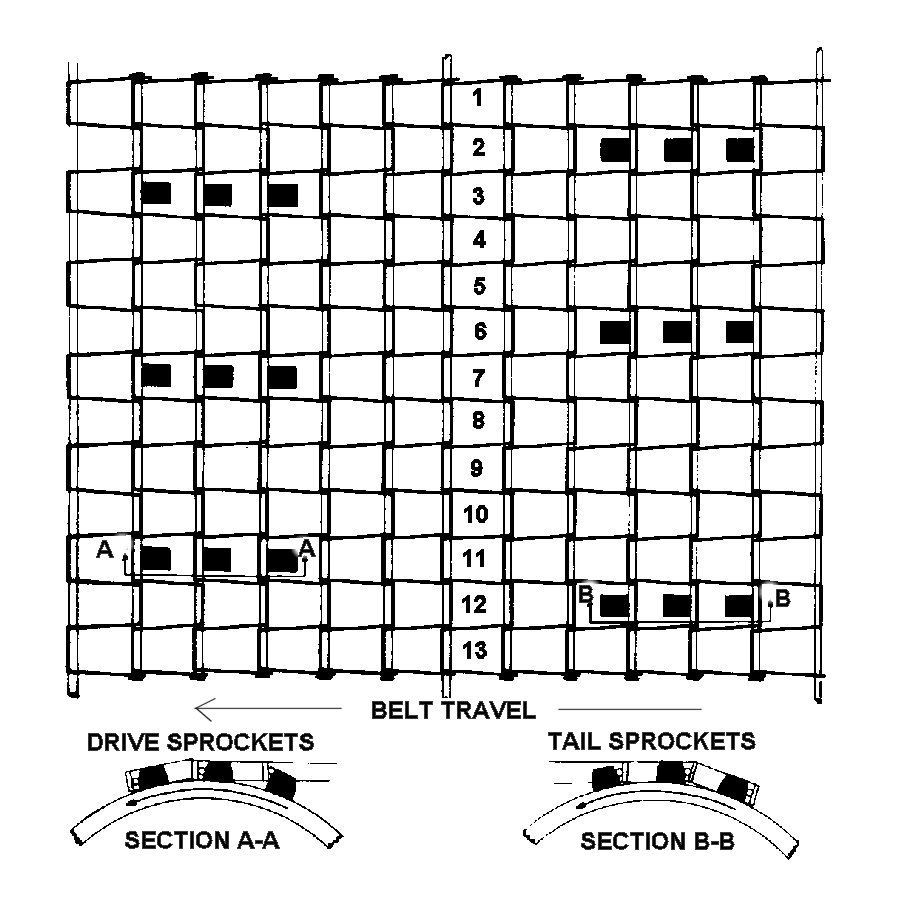SPROCKET DRIVE
Sprockets provide a positive drive of the belt and help keep the belt properly aligned. Conveyor lengths of 50' or less for standard weight belts and 100' or less for heavy duty belts are generally recommended for sprocket drive.
Center to center spacing of sprockets should not exceed 6". In heavy load conditions, spacing of the sprockets should be as close as possible. Sprocket spacing greater than 6" can lead to premature belt failure due to the excessive straon on the connecting rods. Drive sprockets should be keyed to the shaft and tail sprockets should be collared on the shaft to permit free idling - one tail sprocket should be keyed to assure shaft rotation.
FRICTION DRIVE
Friction driving of the belt is preferable to sprocket drive when the loads are relatively heavy and the conveyor lengths are long. Lagged flat face pulleys of as large a diamter as practical are recommended for friction drive. A friction drive system evenly distriubutes the drive tension across the belt and are not subject to rod wear as in a sprocket driven system. To prevent tracking problems, friciton driven belts must be run on an accurately aligned conveyor.
TROUBLESHOOTING
It is very important when mounting sprockets to have the long side of the hubs all facing the same direction. Avoid placing drive sprockets so that they drive on the outside the mesh openings.
Drive sprockets must not be placed in the outside openings on any clinched edge flatwire conveyor belt.
Drive sprockets must always drive against the connector rod.
Drive sprockets should be in the odd numbered openings (see below), Tail sprocket teeth in the even numbers (see diagram below).
All Drive sprockets must be keyed in line.
Never exceed a drive sprocket spacing of over 6". Under heavy loads, spacing should be even less than 6".
If using flight clips, do not place a sprocket in any opening where there is a flight clip.
Sprockets are manufactured to match the belt. Std duty belts require std duty sprockets, Hvy Duty belts require Hvy Duty Sprockets. Do not interchange or mix as tooth height will not match belt height.
1/2 x 1/2 True belts require 1/2 x 1/2 true std sprockets (dual tooth).
If your sprockets on your existing arrangment cannot easily be moved, advise the number of openings on the full
width of your conveyor belt, when re-ordering your belt.
Tail Sprockets should have plain bores (no keyway), although the center sprocket should be keyed.
Plain bore sprockets should be collared to prevent lateral movement.
For Friction Drive, use only lagged, flat faced pulleys.
If you are splicing into an existing belt, you must always provide the number of openings across the full width of
your existing belt, so the new belt can be manufactured with the same openings.
